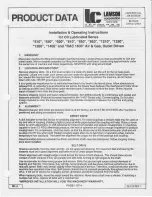
21
before attempting to start and do not push the
primer.
Some snow engine is not equipped
with primer as priming is not needed
for such engine.
4. Turn ignition key to the START position
until engine starts.
To prevent damaging the electric starter, do
not run it more than 5 continuous seconds
each time you try to start. Wait 10 seconds
between each attempt.
5. When the engine starts, release the ignition
key into RUN position and slowly move the
choke control to the OFF position.
Cold Start – Recoil Starter
1. Be sure fuel shutoff valve is in the OPEN
position.
2. Place ON / OFF switch in ON position.
3. Rotate choke control to FULL position.
4. Push the primer 2 or 3 times. When
temperature is below -25oC (15oF),
additional priming may be needed. When
temperature is above 10oC (50oF), priming
is not necessary.
Over priming may cause flooding,
preventing the engine from starting. If you
do flood the engine, wait a few minutes
before attempting to start and do not push the
primer.
5. Grasp recoil starter handle and pull rope out
slowly until it pulls harder. Let rope rewind slowly.
6. Pull rope with a rapid continuous full arm stroke.
Do not allow starter rope to snap back.
7. Repeat steps 5 and 6 until engine starts.
8. When the engine starts, release the recoil starter
handle and slowly move the choke control to the
OFF position.
Warm Start
Follow the steps above, keeping the choke
control in the OFF position and do not use
primer.
Allow the engine to warm up for a few
minutes, engine will not develop full power
until it has reached normal operating
temperature.
In snowy and cold conditions, some
controls and moving parts may freeze. Do
not use excessive force when trying to
operate frozen controls. If you have difficulty
operating any control or part, start the engine and
let is run for a few minutes.
Snow Throwing Tips
It is easier and more efficient to remove snow
immediately after it falls.
The best time to remove snow is the early
morning. At this time the snow is usually dry
and has not been exposed to the direct sun
and warming temperatures.
Slightly overlap each successive path to
ensure all snow will be removed.
For large areas, start in the middle and throw
snow to each side, so snow is not cleared
more than once.
For extremely heavy snow, reduce the width
of snow removal by overlapping previous path
and moving slowly.
Throw snow downwind whenever possible.
Keep engine clean and clear of snow during
use. This will help air flow and extend engine
life.
After snow-throwing is completed, let the
engine run for a few minutes to help dry
off the moisture on the engine and prevent
G
B
Summary of Contents for SPT-182-570
Page 69: ...69 7 Bedienung 1 2 3 4 5 6 7 8 9 10 11 12 13 14 15 16 27 18 19 20 21 22 23 24 25 26 17 28 29 D...
Page 99: ...99 7 K ytt 1 2 3 4 5 6 7 8 9 10 11 12 13 14 15 16 27 18 19 20 21 22 23 24 25 26 17 28 29 F I N...
Page 171: ...171 2 3 SPT 182 570 57 1 B G...
Page 173: ...173 12 5 1 2 B G...
Page 174: ...174 STOP B G...
Page 175: ...175 75 B G...
Page 176: ...176 5 1 2 3 4 5 6 1 7 8 9 10 11 12 B G...
Page 177: ...177 6 1 2 180o 3 1 2 3 4 B G...
Page 178: ...178 5 1 2 B G...
Page 179: ...179 3 4 5 1 2 3 mm 1 8 3 3 1 8 4 B G...
Page 180: ...180 6x37 1 2 3 B G...
Page 181: ...181 4 5 6 B G...
Page 182: ...182 7 1 2 3 4 5 6 7 8 9 10 11 12 13 14 15 16 27 18 19 20 21 22 23 24 25 26 17 28 29 B G...
Page 184: ...184 180o 1 2 3 4 5 B G...
Page 185: ...185 ON FULL OFF ON OFF OFF ON B G...
Page 186: ...186 12V DC 3 STOP RUN START Start 12V DC 120V 230V AC 5 10 3 1 8 1 2 3 5 B G...
Page 187: ...187 1 2 3 a 1 2 B G...
Page 190: ...190 8 GL 5 GL 6 SAE85 95 25 1 2 B G...
Page 191: ...191 3 4 5 6 7 30 1 2 3 4 5 6 7 1 2 B G...
Page 192: ...192 3 4 5 6 7 1 2 3 4 5 B G...
Page 193: ...193 1 2 3 4 5 6 7 8 9 1 2 3 6 7 B G...
Page 194: ...194 4 5 6 7 8 B G...
Page 195: ...195 5 6 9 10 1 2 3 90N m 6 ft lbs 130N m 9 ft lbs 4 1 2 3 4 B G...
















































